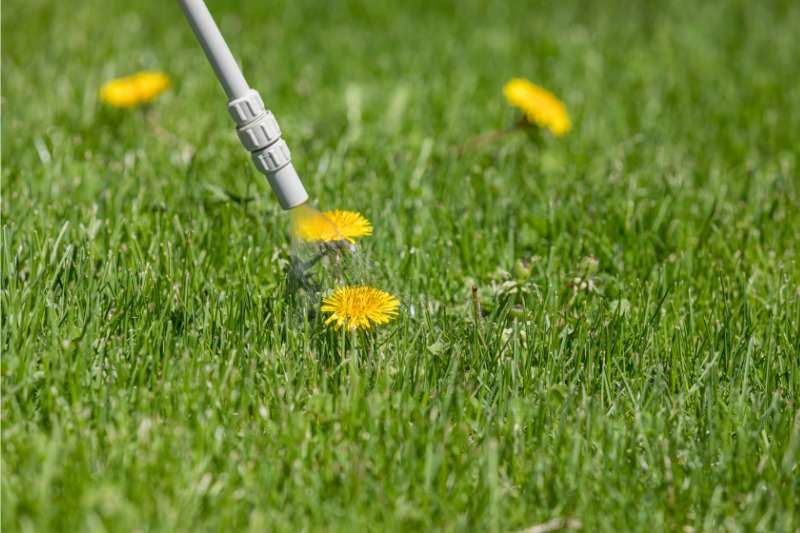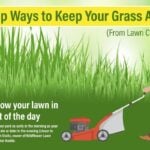
While weed and feed conveniently allows homeowners to apply chemicals to their lawn that can zap away weeds and nourish the grass simultaneously, the combination of active ingredients must be applied at the right time. This article discusses how to use weed and feed for your lawn correctly so that both parts of the product – the “weed” and the “feed” – each do their jobs.
Keep reading to learn what weed and feed is, how to apply it, how it works, and safety precautions.
- The Best Time to Apply Weed and Feed
- How to Get Your Lawn Ready for a Weed and Feed Application
- How to Apply Weed and Feed in 4 Steps
- How Long to Avoid the Lawn After Applying Weed and Feed
- Reasons Weed and Feed is Sometimes Ineffective
- How to Find the Right Weed and Feed
- FAQ About How and When to Use Weed and Feed
The Best Time to Apply Weed and Feed
The best time to apply weed and feed is when daytime temperatures are between 60 and 90 degrees Fahrenheit. This is typically in the early fall and/or late spring for most regions. Fall and spring are the best times to manage perennial weeds and many annual weed species.
This time of year is also favorable for lawn fertilization. Late spring is the ideal time to fertilize your lawn if you have a warm-season grass, like St. Augustine or Bermuda. Fall is the optimal time to fertilize cool-season grasses, like Kentucky bluegrass and fescues.
For weed and feed products containing nitrogen: Do not apply these types of weed and feed products until the soil temperature at 4 inches deep consistently reaches 65 degrees Fahrenheit. Potassium-heavy weed and feeds can be applied at the end of winter or early spring.
Grass must be fertilized at specific times and intervals to thrive. The appropriate time to apply weed control and fertilizer does not always coincide, which is one reason weed and feed can be bad for your lawn.
Weed and feed should not be applied more than twice a year, and avoid using it during extreme temperatures, droughts, or windy days.
How to Get Your Lawn Ready for a Weed and Feed Application

Choose a day to apply weed and feed when there is no rain forecasted for about a week. This will keep water from washing the product away before it takes effect.
For newly seeded lawns, do not apply weed and feed until after you have had to mow the grass twice. Applying herbicide to new grass sooner than this can keep it from growing.
Mow grass to a normal height about two days before applying weed and feed to help the product absorb evenly. To help granules adhere to the weeds, water your grass so that it is slightly damp when you apply the weed and feed.
How to Apply Weed and Feed in 4 Steps
To reduce your exposure to the toxic chemicals contained in most weed and feed products, wear long sleeves, long pants, a face mask, and eye protection when applying weed and feed.
Using the proper tools for application is also important. You’ll need a backpack or pump sprayer for liquid weed and feed and a fertilizer spreader for granular weed and feed.
Preparing the two forms is also different. For liquid weed and feed, follow the product label’s directions for mixing the concentrated liquid with water. For granular weed and feed, adjust the spreader settings according to the product label’s recommendations.
Once you have the right tool and the right settings for your specific weed and feed product, follow these four steps to apply it to your lawn:
- Step 1: Load the weed and feed into your spreader or sprayer with the amount the package instructs.
- Step 2: Shield nearby plants you want to preserve by placing plastic over them or using a drop spreader, which drops granules in a specific location to prevent overapplication instead of broadcasting them widely.
- Step 3: Begin at the perimeter of your lawn and go back and forth in parallel lines, ensuring consistent application. Follow your lawn mowing pattern but slightly overlap each pass to guarantee complete coverage.
- Step 4: Avoid watering and mowing your lawn after application. Resume regular lawn maintenance tasks when the product label recommends. If there are no guidelines on your product’s package, wait at least 24 hours before watering the lawn.
How Long to Avoid the Lawn After Applying Weed and Feed
Do not allow children and pets in the treated area for at least 24 hours but preferably for as long as 72 hours to be safe. It’s best to wait until after a heavy rainfall or watering the lawn before allowing children and pets back on the grass. Water can wash away residuals from the herbicide.
If you applied granular weed and feed, do not allow children and pets on the lawn until the granules are no longer visible.
Weed and feed products contain a mixture of toxic chemicals, like 2,4-D, dicamba, and MCPP. Some of these are associated with chronic health issues, including cancer.
For safer alternatives, you can treat weeds with homemade weed killer and fertilize the grass separately. Read our article How to Make Homemade Weed Killer to learn more. You can also try corn gluten meal, a natural and non-toxic option that can act as a weed and feed if applied correctly.
Reasons Weed and Feed is Sometimes Ineffective

Several determinants can affect whether weed and feed works. One major factor is the types of lawn weeds you are battling. Some herbicides only work on broadleaf weeds, while others only work on grassy weeds. Make sure the weed and feed product you purchase contains the right herbicide to battle the types of weeds in your lawn.
The timing of rain or watering after application can also render weed and feed ineffective. Water can wash away the product.
Moreover, weed and feed must be applied during the right stage in the weed’s life cycle to be effective. If your weed and feed product contains a pre-emergent herbicide, it must be applied before the weeds germinate. If it contains a post-emergent herbicide, it must be applied while the weeds are actively growing but preferably while they’re still young and vulnerable for best results.
Proper preparation, timing, and understanding of the product and its application increase the chances weed and feed will work as both a weed killer and fertilizer on your lawn.
How to Find the Right Weed and Feed
To choose the right weed and feed, homeowners must identify what type of weeds they have and their grass type. Read product labels to ensure the herbicide effectively eliminates your specific weeds and is suitable for your grass type and its growth stage.
Our reviews of the best weed and feed products can help you find a reliable weed and feed that suits your specific needs.
FAQ About How and When to Use Weed and Feed
Scotts Turf Builder kills several common weeds, like chickweed and henbit, and is safe for centipedegrass and Bahiagrass. Ace Lawn Weed Killer is safe for Bermudagrass and Zoysiagrass.
Scotts Turf Builder is safe for ryegrass and fescues. Both Scotts Turf Builder and Ace Lawn Weed Killer are safe for Kentucky bluegrass.
Use a broom or rake to push chemicals that have spilled onto the sidewalk or road back into your grass. This reduces the runoff that washes into storm drains and harms the environment.
After applying weed and feed, wait at least four weeks before reseeding or overseeding your lawn. Any sooner, and the herbicide in the weed and feed could keep your new grass from growing.
Final Thoughts
Once you’ve treated your grass with weed and feed, you’ll want to practice good lawn care habits to reduce the risk of weeds returning. This includes fertilizing, dethatching, and aerating on the right schedule for your grass type. Our guide to Lawn Care for Beginners (in 13 Easy Steps) will tell you everything you need to know.
Or, if you don’t want to decode weeding, fertilizing, and maintaining a healthy lawn on your own, let LawnStarter connect you with qualified lawn care pros in your area to do it for you.
Main Image Credit: groveb / Canva Pro / License





